How indoor air quality data can help you juggle competing priorities.
One of the biggest pressures weighing on Facility Managers is making the right choices in the face of competing demands.
You are expected to be reactive, responding to constant complaints about temperature and humidity – or to HR's demand for more ventilation to reduce the incidence of colds and viruses. You need to be more flexible, while responding faster.
 At the same time your role is becoming more strategically important, where you are called upon to take long-term preventative measures to optimize spaces. Facility managers’ goals now often include boosting performance, improving overall health and refining the customer experience.
At the same time your role is becoming more strategically important, where you are called upon to take long-term preventative measures to optimize spaces. Facility managers’ goals now often include boosting performance, improving overall health and refining the customer experience.
Yet while being asked to deliver more, eroded budgets mean you have to keep costs down and explain every penny you spend. Drowning in complaints and flooded with new KPIs, justifying workflow and budget priorities is becoming increasingly difficult. To action anything, you need evidence.
 With the need to save money, improve efficiencies and provide better service, many Facility Managers are turning to indoor air quality monitors and radon detection devices. These systems not only improve the environment, but also take the friction out of prioritizing and resolving competing demands and complaints, by allowing Facility Managers to leverage the data these devices record to provide compelling evidence and raise work orders.
With the need to save money, improve efficiencies and provide better service, many Facility Managers are turning to indoor air quality monitors and radon detection devices. These systems not only improve the environment, but also take the friction out of prioritizing and resolving competing demands and complaints, by allowing Facility Managers to leverage the data these devices record to provide compelling evidence and raise work orders.
Better data and better reporting will improve how you make decisions, making your job much easier.

What does data look like from indoor air quality and radon monitoring?
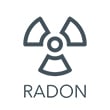 |
Radon
|
Radon is a naturally occurring radioactive gas emanating from the ground. It's all around us, but in different concentrations at different times. The problem is, it's a carcinogen, so more exposure to higher concentrations over a longer period can have health effects. This is why it's the number one cause of lung cancer among non-smokers.
As radon levels fluctuate, to see the full picture you need data from consistent monitoring all year long. That way you can ensure any mitigation steps you've taken are effective. With increasing regulations around radon, it makes sense to act now to protect you and those around you.
 |
Total VOCs
|
TVOCs stands for total volatile organic compounds, which are the total amount of any emitted gases with short or long-term health effects. They are emitted from paints, varnishes, finishes and cleaning products.
Total VOCs can cause serious health effects in both the short and long term. Health effects vary from minor eye, nose and throat irritations all the way to liver and kidney damage or cancer, depending on the level of exposure.
So if you've just had improvements to your rental or had an area refurbished, repainted or recarpeted, increasing the ventilation will help dispel the total VOCs they emit. However, total VOCs can be reintroduced into the indoor environment from the use of some common materials, including cleaning supplies, air fresheners, pesticides, aerosol sprays and even furniture.
Monitoring their levels will give you data that will tell you whether to increase ventilation, reduce the use of products that emit them or more regularly replace air filters in your indoor fan systems.
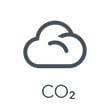 |
Carbon dioxide (CO2)
|
This naturally occurring gas is harmless in small quantities. Every time we breathe out, we emit it. But if you have a room full of people with not much ventilation, eventually you will have high enough concentrations for it to be harmful. This can cause headaches, restlessness and drowsiness, which in turn has a detrimental effect on decision making and can result in low productivity.
CO2 levels can climb according to the ventilation rate of the building. More and more buildings are sealed airtight to meet environmental targets. Many ventilation systems recycle air to conserve energy. This results in high CO2 concentrations and poor indoor air quality, which have been directly correlated to low productivity, high sick leave and infectious disease transmission.
Track the levels of your indoor CO2 to keep a tab on levels in excess of 1,000ppm. Your readings will let you know when to ventilate with more fresh air, eliminating a common cause of complaints.
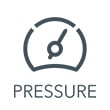 |
Pressure
|
Atmospheric or barometric pressure changes according to the weather. Low pressure indicates rain is on the way, while high pressure is associated with dry, sunny days.
Monitoring pressure will arm you with the data to take proactive steps towards controlling indoor humidity. That way you can ward off mold if it's damp or prevent the air from getting too dry, which can encourage the transmission of some nasty bugs, such as influenza, especially if it's cold.
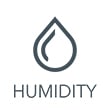 |
Humidity
|
Dry air may not seem dangerous, but it can make infectious disease transmission easier, while more humid conditions can cause mold growth and worsen asthma symptoms.
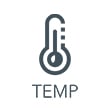 |
Temperature
|
Regular temperature readings will allow you to find the optimal range for your building's users. The wrong temperature can drastically affect performance and wellbeing at work.
There is even a difference between how temperature affects cognitive performance for men and women. A recent study showed that men perform better when it's cooler, and for women it's the opposite – they need to be around three degrees warmer.
Using temperature data to get the balance right will help drive up productivity and reduce complaints.

How to make data-driven decisions

Every insight within indoor air quality and radon monitoring is actionable for work orders, and not always in the way you think. Simple problems, such as high temperatures, can be easily dealt with by opening windows – but your indoor air quality system datasets can empower you to do much more.
These are our top ten tips to get the most out of your indoor air quality and radon data:
- Record all data on all sensors before and after ventilation to provide evidence that the room meets legal standards for occupation. Or, if it falls below standards, you can use it to show justification for opening a work order to rectify it – which you can send to your HVAC partner.
- If you’re aiming for a WELL standard, you can use your indoor air quality data as evidence of compliance, as well as to develop more efficient pathways for maintaining the standard. To keep pace with the evolution of the standard to V2, you will need to submit your data over a portal to participate in the new digital version.
- As different rooms change their capacity and usage, use your indoor air quality data to adjust ventilation, or justify when it should be on or off.
- Understanding total VOC levels will lead to better decisions for types of cleaning products and air fresheners, as well as the composition of fixtures and furnishings.
- Take an evidence-based decision when resolving arguments about temperature. You can safely raise the temperature by one degree to improve performance for your female colleagues without compromising your male colleagues’ performance, according to this study.
- Use your radon monitoring data to keep control of mitigation costs. This way you can measure the effects of mitigation, starting with the cheapest and simplest techniques, progressing to the more detailed fixes as necessary.
- Establish a data-driven approach to indoor air quality. It will enable you to evidence the root cause of any problem, help you get sign off for your plans to tackle them and then measure the results of the actions you took.
- Your data-driven approach will reduce the number of return calls for the same issue, leading to cost reductions.
- Use your data to prioritize your workflow, not just in terms of urgency, but also in terms of impact on wellbeing, productivity and budget.
- Your data will help you demonstrate the value of indoor air quality to senior decision makers and validate Facility Management's contribution to overall performance.
Get the right data with the right equipment

The right system should not only provide you with the means to easily monitor indoor air quality, radon and ventilation, but also to make sense of the data you record through meaningful reporting.
These are the features you should look for:
- Easily installation – no wires, just mount detection units on the wall
- Remote monitoring, with excellent range
- Full reporting from multiple sensors
- API options that will allow you to integrate with other systems
- Encrypted data and easy retrieval
- Long battery life
As more and more leaders and employees become aware of the role indoor air quality plays in wellness at work and overall performance, expect demands and complaints to increase around these issues. The right data will help you manage expectations, juggle competing priorities and make the best decisions.
Takeaways
- Facility managers are typically weighed down by competing demands but data can help you prioritize.
- The right indoor air quality data can allow you to boost performance while keeping costs down.
- Key measurements include radon, CO2, total VOCs, humidity, pressure and temperature.
- The right data will provide support for your decision-making and evidence that your actions are effective.
- To get the right data, you need the right equipment.

 Most popular
Most popular
 NEW
NEW




 Radon
Radon
 Radon
Radon


.webp)


 With the need to save money, improve efficiencies and provide better service, many Facility Managers are turning to
With the need to save money, improve efficiencies and provide better service, many Facility Managers are turning to 


